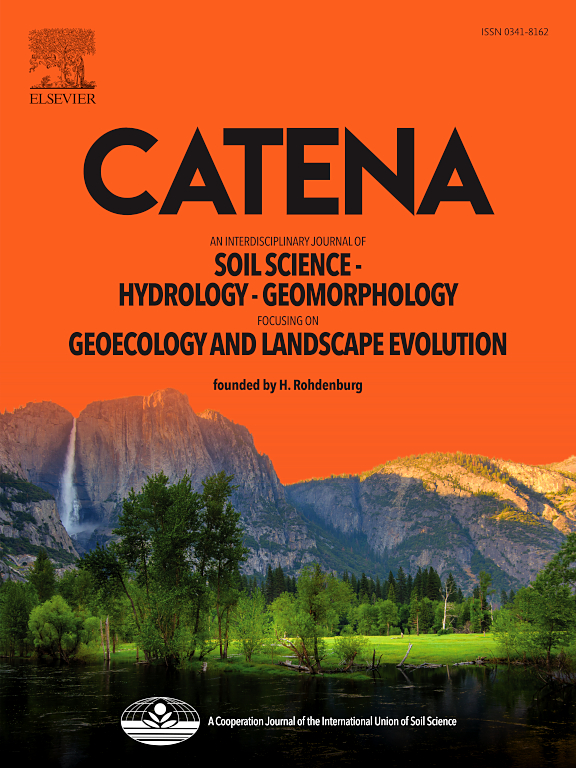The impact of weathering, iron oxides, and aluminous clays on organic carbon storage and stability in an extensive tropical river system
IF 5.4
1区 农林科学
Q1 GEOSCIENCES, MULTIDISCIPLINARY
引用次数: 0
Abstract
Understanding the factors controlling organic carbon (OC) dynamics in tropical river systems is essential for evaluating their role in global carbon cycling. This study explores how mineralogical composition, particularly aluminous clays and pedogenic iron oxides (Fed), influences OC storage and stability in the Ganges–Brahmaputra (G–B) river system within the Bengal Basin. The G-B river system transports substantial terrestrial organic matter (OM) into the Bay of Bengal, making it a key component of the global carbon cycle. The Brahmaputra River sediments are enriched with C3 plant-derived OM, as indicated by lower δ13C values (−24.0 ‰) compared to those from the Ganges (−23.8 ‰ to − 22.4 ‰). A significant drop in OC content in the Indo-Gangetic Floodplain (0.27 % to 0.03 %), followed by an increase in the Bengal Basin (0.15 %), suggests partial oxidation of Himalayan OC, which is subsequently replaced by OC from floodplain sources during downstream transport. Clay content (3.7 ± 2.0 %) and Fed concentration (0.13 ± 0.07 %) in Ganges River sediments are significantly lower than those of the Brahmaputra (7 ± 2.3 % and 0.30 ± 0.07 %, respectively). Illite, a dominant clay mineral, exhibits a strong positive correlation with OC content, while smectite shows a negative correlation, likely due to its secondary formation, short interaction time with OM, and limited OC retention capacity. Fed significantly contributes to OC preservation through interacting with minerals, particularly in chemical-weathered regions. Regression analysis identifies Fed and illite as the most influential factors in OC storage, contributing 52 % and 48 %, respectively, while grain size shows a minor negative impact. The heavy fraction of OM, comprising over 90 % of total OC, underscores the importance of mineral-associated OC (OCMA) in long-term storage. Enhanced chemical weathering in the Ganges floodplains destabilizes pre-formed OCMA, reducing OC storage (∼25 %) and increasing CO2 emissions. These findings highlight that floodplain weathering significantly influences OC fate during sediment transport, and position tropical river systems as significant CO2 sources to the atmosphere.
风化、氧化铁和铝质粘土对广泛的热带河流系统中有机碳储存和稳定性的影响
了解热带河流系统有机碳动态的控制因素对评估其在全球碳循环中的作用至关重要。本研究探讨了矿物组成,特别是铝质粘土和成土氧化铁(Fed),如何影响孟加拉盆地恒河-布拉马普特拉河(G-B)水系的OC储存和稳定性。G-B河系统将大量陆生有机物(OM)输送到孟加拉湾,使其成为全球碳循环的关键组成部分。雅鲁藏布江沉积物的δ13C值(- 23.8‰~ - 22.4‰)低于恒河沉积物(- 23.8‰~ - 22.4‰),富集C3植物源有机质。印度-恒河漫滩OC含量显著下降(0.27% - 0.03%),随后在孟加拉盆地OC含量增加(0.15%),表明喜马拉雅OC部分氧化,随后在下游运输过程中被漫滩来源的OC取代。恒河沉积物中粘土含量(3.7±2.0%)和Fed浓度(0.13±0.07%)显著低于雅鲁藏布江沉积物(分别为7±2.3%和0.30±0.07%)。黏土矿物伊利石与OC含量呈显著正相关,蒙脱石与OC含量呈显著负相关,可能是由于其次生形成、与OM相互作用时间短、OC保留能力有限。通过与矿物质的相互作用,特别是在化学风化地区,Fed对OC的保存起着重要的作用。回归分析表明,Fed和伊利石对碳储量的影响最大,分别贡献了52%和48%,而粒径对碳储量的影响较小。有机质的重质组分,占总OC的90%以上,强调了矿物相关OC (OCMA)在长期储存中的重要性。恒河漫滩的化学风化作用增强,破坏了预形成的OCMA的稳定性,减少了OC的储存(约25%),增加了CO2的排放。这些发现突出表明,洪泛平原风化作用显著影响沉积物输运过程中OC的命运,并将热带河流系统定位为大气中重要的CO2源。
本文章由计算机程序翻译,如有差异,请以英文原文为准。
求助全文
约1分钟内获得全文
求助全文
来源期刊

Catena
环境科学-地球科学综合
CiteScore
10.50
自引率
9.70%
发文量
816
审稿时长
54 days
期刊介绍:
Catena publishes papers describing original field and laboratory investigations and reviews on geoecology and landscape evolution with emphasis on interdisciplinary aspects of soil science, hydrology and geomorphology. It aims to disseminate new knowledge and foster better understanding of the physical environment, of evolutionary sequences that have resulted in past and current landscapes, and of the natural processes that are likely to determine the fate of our terrestrial environment.
Papers within any one of the above topics are welcome provided they are of sufficiently wide interest and relevance.
 求助内容:
求助内容: 应助结果提醒方式:
应助结果提醒方式:


